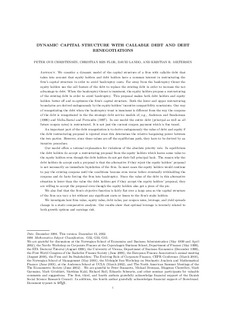| dc.description.abstract | We consider a dynamic model of the capital structure of a firm with callable debt that takes into account that equity holders and debt holders have a common interest in restructuring the firm’s capital structure in order to avoid bankruptcy costs. Far away from the bankruptcy threat the equity holders use the call feature of the debt to replace the existing debt in order to increase the tax advantage to debt. When the bankruptcy threat is imminent, the equity holders propose a restructuring of the existing debt in order to avoid bankruptcy. This proposal makes both debt holders and equity holders better off and re-optimize the firm’s capital structure. Both the lower and upper restructuring boundaries are derived endogenously by the equity holders’ incentive compatibility constraints. Our way of renegotiating the debt when the bankruptcy treat is imminent is different from the way the coupons of the debt is renegotiated in the the strategic debt service models of, e.g., Anderson and Sundaresan (1996) and Mella-Barral and Perraudin (1997). In our model the entire debt (principal as well as all future coupon rates) is restructured. It is not just the current coupon payment which is fine tuned.
An important part of the debt renegotiation is to derive endogenously the value of debt and equity if the debt restructuring proposal is rejected since this determines the relative bargaining power between the two parties. However, since these values are off the equilibrium path, they have to be derived by an iterative procedure.
Our model offers a rational explanation for violations of the absolute priority rule. In equilibrium the debt holders do accept a restructuring proposal from the equity holders which leaves some value to the equity holders even though the debt holders do not get their full principal back. The reason why the debt holders do accept such a proposal is that the alternative if they reject the equity holders’ proposal is not necessarily an immediate liquidation of the .rm. In most cases the equity holders would continue to pay the existing coupons until the conditions become even worse before eventually withholding the coupons and de facto forcing the firm into bankruptcy. Since the value of the debt in this alternative situation is lower than the value the debt holders get if they accept the equity holders’ proposal, they are willing to accept the proposal even though the equity holders also get a piece of the pie.
We also find that the firm’s objective function is fairly .at over a large area so the capital structure of the firm can vary a lot without any significant costs or losses to the firm’s stake holders.
We investigate how firm value, equity value, debt value, par coupon rates, leverage, and yield spreads change in a static comparative analysis. Our results show that optimal leverage is inversely related to both growth options and earnings risk. | en |
